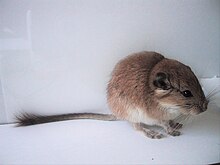Tympanoctomys
| Tympanoctomys | |
|---|---|

| |
| Plains viscacha rat, Tympanoctomys barrerae | |
| Scientific classification | |
| Domain: | Eukaryota |
| Kingdom: | Animalia |
| Phylum: | Chordata |
| Class: | Mammalia |
| Order: | Rodentia |
| Family: | Octodontidae |
| Genus: | Tympanoctomys Yepes, 1942[1] |
| Type species | |
| Octomys barrerae B. Lawrence, 1941
| |
| Species | |
|
T. barrerae (B. Lawrence, 1941) | |
Tympanoctomys is a genus of rodent in the family Octodontidae. There are three extant species in the genus: T. barrerae,[2] T. kirchnerorum[3] and T. loschalchalerosorum.[4] T. loschalchalerosorum was formerly considered to be monotypic within the genus Salinoctomys, but has been shown by genetic analysis to nest within the variation of T. barrerae.[4]
All species are endemic to central western Argentina, where the genus has a fragmented range. Their natural habitat is desert scrubland, dunes and salt flats, where they eat halophyte plants. They are solitary, nocturnal rodents that construct large mounds with complex burrows.[3]
References
- ^ Lawrence, B. (1941), "A new species of Octomys from Argentina", Proceedings of the New England Zoological Club, 18: 43–46.
- ^ Woods, C.A.; Kilpatrick, C.W. (2005). "Infraorder Hystricognathi". In Wilson, D.E.; Reeder, D.M (eds.). Mammal Species of the World: A Taxonomic and Geographic Reference (3rd ed.). Johns Hopkins University Press. p. 1573. ISBN 978-0-8018-8221-0. OCLC 62265494.
- ^ a b Pablo Teta; Ulyses F. J. Pardiñas; Daniel E. Udrizar Sauthier & Milton H. Gallardo (2014), "A new species of the tetraploid vizcacha rat Tympanoctomys (Caviomorpha, Octodontidae) from central Patagonia, Argentina", Journal of Mammalogy, 95 (1): 60–71, doi:10.1644/13-MAMM-A-160, hdl:11336/22721
- ^ a b Suárez-Villota, E. Y.; González-Wevar, C. A.; Gallardo, M. H.; Vásquez, R. A.; Poulin, E. (December 2016). "Filling phylogenetic gaps and the biogeographic relationships of the Octodontidae (Mammalia: Hystricognathi)". Molecular Phylogenetics and Evolution. 105: 96–101. doi:10.1016/j.ympev.2016.08.015. hdl:10533/227937.